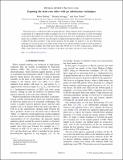| dc.contributor.author | Maltoni, Fabio | |
| dc.contributor.author | Selvaggi, Michele | |
| dc.contributor.author | Thaler, Jesse | |
| dc.date.accessioned | 2016-11-03T22:31:50Z | |
| dc.date.available | 2016-11-03T22:31:50Z | |
| dc.date.issued | 2016-09 | |
| dc.date.submitted | 2016-06 | |
| dc.identifier.issn | 2470-0010 | |
| dc.identifier.issn | 2470-0029 | |
| dc.identifier.uri | http://hdl.handle.net/1721.1/105195 | |
| dc.description.abstract | The dead cone is a well-known effect in gauge theories, where radiation from a charged particle of mass m and energy E is suppressed within an angular size of m/E. This effect is universal as it does not depend on the spin of the particle nor on the nature of the gauge interaction. It is challenging to directly measure the dead cone at colliders, however, since the region of suppressed radiation either is too small to be resolved or is filled by the decay products of the massive particle. In this paper, we propose to use jet substructure techniques to expose the dead cone effect in the strong-force radiation pattern around boosted top quarks at the Large Hadron Collider. Our study shows that with 300/fb of 13–14 TeV collision data, ATLAS and CMS could obtain the first direct evidence of the dead cone effect and test its basic features. | en_US |
| dc.description.sponsorship | MIT-Belgium Program | en_US |
| dc.description.sponsorship | United States. Dept. of Energy (Cooperative Research Agreement DE-SC-00012567) | en_US |
| dc.description.sponsorship | United States. Dept. of Energy (Early Career Research Program DE-SC-0006389) | en_US |
| dc.publisher | American Physical Society | en_US |
| dc.relation.isversionof | http://dx.doi.org/10.1103/PhysRevD.94.054015 | en_US |
| dc.rights | Article is made available in accordance with the publisher's policy and may be subject to US copyright law. Please refer to the publisher's site for terms of use. | en_US |
| dc.source | American Physical Society | en_US |
| dc.title | Exposing the dead cone effect with jet substructure techniques | en_US |
| dc.type | Article | en_US |
| dc.identifier.citation | Maltoni, Fabio, Michele Selvaggi, and Jesse Thaler. “Exposing the Dead Cone Effect with Jet Substructure Techniques.” Physical Review D 94.5 (2016): n. pag. © 2016 American Physical Society | en_US |
| dc.contributor.department | Massachusetts Institute of Technology. Center for Theoretical Physics | en_US |
| dc.contributor.department | Massachusetts Institute of Technology. Department of Physics | en_US |
| dc.contributor.mitauthor | Thaler, Jesse | |
| dc.relation.journal | Physical Review D | en_US |
| dc.eprint.version | Final published version | en_US |
| dc.type.uri | http://purl.org/eprint/type/JournalArticle | en_US |
| eprint.status | http://purl.org/eprint/status/PeerReviewed | en_US |
| dc.date.updated | 2016-09-14T22:00:21Z | |
| dc.language.rfc3066 | en | |
| dc.rights.holder | American Physical Society | |
| dspace.orderedauthors | Maltoni, Fabio; Selvaggi, Michele; Thaler, Jesse | en_US |
| dspace.embargo.terms | N | en_US |
| dc.identifier.orcid | https://orcid.org/0000-0002-2406-8160 | |
| mit.license | PUBLISHER_POLICY | en_US |
